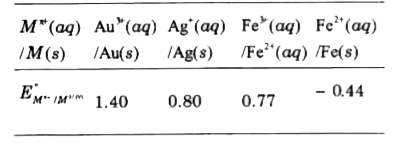Consider the following standard reduction potentials
For the voltaic cell reaction below , calculate the concentration ( in M) that would be needed to produce a cell potential equal to 0.16 V at when
Solution in Telugu
The correct Answer is:D
Topper's Solved these Questions
- BOOK - AAKASH SERIESCHAPTER - ELECTROCHEMISTRY EXERCISE - LEVEL-II (LECTURE SHEET ( EXERCISE -II (LINKED COMPREHENSION TYPE QUESTIONS )) )12videos
ELECTROCHEMISTRY
- BOOK - AAKASH SERIESCHAPTER - ELECTROCHEMISTRY EXERCISE - LEVEL-II (LECTURE SHEET ( EXERCISE -III(MATCH THE FOLLOWING QUESTIONS )))6videos
ELECTROCHEMISTRY
- BOOK - AAKASH SERIESCHAPTER - ELECTROCHEMISTRY EXERCISE - LEVEL-I ( EXERCISE-II)51videos
ELECTROCHEMISTRY
- BOOK - AAKASH SERIESCHAPTER - DILUTE SOLUTIONSEXERCISE - EXERCISE - 1.255videos
DILUTE SOLUTIONS
- BOOK - AAKASH SERIESCHAPTER - ELEMENTS OF D - BLOCKEXERCISE - EXERCISE - 5.233videos
ELEMENTS OF D - BLOCK
Similar Questions
The E∘ values for the changes given below are measured against NHE at 27∘C
Cu2++e→Cu+,E∘=+0.15V,
Cu++e→Cu,E∘=+0.50V,
Zn2++2e→Zn,E∘=−0.76V.
The temperature coefficient of emf a cell designed as Zn∣∣Zn2+∣∣∣∣Cu2+∣∣∣Cu is −1.4×10−4v per degree . For a cell reaction in equilibrium ΔG=0andΔG∘=−2.303RTlogKc. The heat of reaction and entropy changes during the reaction are related by ΔG=ΔH−TΔS.
The E∘ for the reaction 2Cu+→Cu2++Cu is :02:07View SolutionMatch the following
 07:37View Solution
07:37View SolutionDuring the electrolysis of cryolite, aluminium and fluorine are formed in .... molar ratio
02:50View SolutionWhat are the factor on-which solubility depends on ?
07:16View SolutionGive some examples for the ions with pseudo inert gas electronic configuration.
03:40View SolutionE^(@) = 0.93V for the reactions: Fe(s) + 2M^(+)(aq) rightarrow Fe^(2+)(aq) + 2M(s) What is the standard potential for M^(+) + e^(-) rightarrow M , if E_(Fe^(2+//Fe)^(@) = -0.44 V ?
07:16View SolutionCalculate the standard cell potential (in V) of the cell in which following reaction takes place: Fe ^( 2 + ) ( aq ) + A g^ + ( aq ) to Fe ^( 3 + ) ( aq ) + Ag (s ) Given that E _ (Ag ^ + // Ag ) ^ 0 = x V , E _ ( Fe^( 2+ ) // Fe ) ^0 = yV , E _ (Fe^(3+)//F e )^0 = z V
04:04View Solutionकुछ अर्द्ध-अभिक्रियाओं के इलेक्दोड विभव इस प्रकार हैं
Fe3+(aq)+e−→Fe2+(aq),E0=0.76V
Ce4+(aq)+e−→Ce3+(aq),E0=1.60V क्या Fe3+“से”Ce3+ ऑक्सीकृत होगा।01:34View SolutionStandard electrode potential data is given below : Fe^(3+) (aq) + e ^(-) rarr Fe^(2+) (aq) , E^(o) = + 0.77 V Al^(3+) (aq) + 3e^(-) rarr Al (s) , E^(o) = - 1.66 V Br_(2) (aq) + 2e^(-) rarr 2Br^(-) (aq) , E^(o) = +1.08 V Based on the data given above, reducing power of Fe^(2+) Al and Br^(-) will increase in the order :
View Solutionनिम्नलिखित अपचयन अभिक्रियाओं के E0 मान इस प्रकार हैं -
Fe3+(aq)+e−→Fe2+(aq),E0=0.771V
Fe2+(aq)+2e−→Fe(s),E0=−0.447V
अभिक्रिया, Fe3+(aq) + 3e^(-) rarr Fe(s) के लिए मुक्त ऊर्जा परिवर्तन क्या होगा?01:38View SolutionStandard electrode potential data is given below :
Fe3+(aq)+e−→Fe2+(aq),Eo=+0.77V
Al3+(aq)+3e−→Al(s),Eo=−1.66V
Br2(aq)+2e−→2Br−(aq),Eo=+1.08V
Based on the data given above, reducing power of Fe2+ Al and Br− will increase in the order :10:07View SolutionConsider the following half-cell reaction and associated standerd half-cell potentials and determine the maximum voltage thatr can be obtained by combination resulting in spontenous process :
AuBr−4(aq)+3e−→Au(s)+4BR−(aq),E∘=−086V
Eu3+(aq)+e−→Eu2+(aq),E∘=−043V
Sn2+(aq)+2e−→Sn(s),E∘=−0.14V
IO−(aq)+H2O(l)+2e−→I−(aq)+2OH−,E∘=+0.49V02:36View SolutionCalculate the standard reduction potentials of galvanic cells in which reaction are Fe^(2+) (aq) + Ag^(+) (aq) to Fe^(3+) (aq) + Ag (s) Given that E^(Theta) (Cr^(3+) //Cr) = -0.74 V , E^(Theta) (Cd^(2+) // Cd) = -0.40 V , E^(Theta) (Fe^(3+) // Fe^(2+)) = 0.77 V , E^(Theta) (Ag^(+) // Ag) = 0.80 V
02:36View SolutionCalculate the standard cell potentials of galvanic cell in which the following reactions take place:
(i) 2Cr(s)+3Cd2+(aq)→2Cr3+(aq)+3Cd
(ii) Fe2+(aq)+Ag+(aq)→Fe3+(aq)+Ag(s)
Given: ECr3+,Cr=−0.74V,E∘Cd2+,Cd=−0.04V,EAg+,Ag=0.80V,E∘Fe3+,Fe2+=0.77V.
Calculate the ΔrG∘ and equilibrium constant of the reactions.04:10View Solutionसेल Zn(s)∣∣Zn2+(aq)∣∣∣∣Mx+(aq)∣∣M(s) के लिए विभिन्न अर्द्ध-सेल तथा मानक इलेक्ट्रोड विभव नीचे दिये गये हैं

यदि E∘Zn3+/Zn =-0.76V, तो प्रति इलेक्ट्रॉन स्थानान्तरण के लिए कौन कैथोड़ का E∘cell सर्वाधिक होगा04:03View Solution

